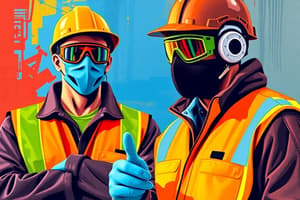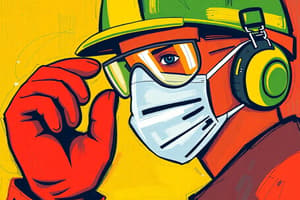Podcast
Questions and Answers
What is the first step in developing a comprehensive safety and health program including personal protective equipment?
What is the first step in developing a comprehensive safety and health program including personal protective equipment?
Perform a hazard assessment
Which of the following types of hard hats are NOT ANSI approved?
Which of the following types of hard hats are NOT ANSI approved?
- Type I hard hats
- Full brim hard hats
- Type II hard hats
- Bump Hats (correct)
All respiratory protection equipment must be approved by?
All respiratory protection equipment must be approved by?
NIOSH
What type of footwear may be designed to be electrically conductive or non-conductive?
What type of footwear may be designed to be electrically conductive or non-conductive?
If an employee who needs eye protection wears prescription lenses, he or she should:
If an employee who needs eye protection wears prescription lenses, he or she should:
If the employee provides his or her own protective equipment, the employee is responsible for?
If the employee provides his or her own protective equipment, the employee is responsible for?
If employees use a respirator under any circumstances, what should the employer have?
If employees use a respirator under any circumstances, what should the employer have?
If a hard hat sustains impact, what should happen to it?
If a hard hat sustains impact, what should happen to it?
These gloves offer good pliability and protect against harmful elements such as hydraulic fluids, gasoline, and alcohols:
These gloves offer good pliability and protect against harmful elements such as hydraulic fluids, gasoline, and alcohols:
Eye and face protection selected for employee use must clearly identify the?
Eye and face protection selected for employee use must clearly identify the?
Flashcards
First step in safety program development?
First step in safety program development?
The first step is to perform a thorough hazard assessment to identify potential risks.
Are bump hats ANSI approved?
Are bump hats ANSI approved?
Bump hats are not ANSI-approved for protection against impacts.
Respirator approval body?
Respirator approval body?
All respiratory protection equipment must be approved by the National Institute for Occupational Safety and Health.
Electrical properties of safety shoes?
Electrical properties of safety shoes?
Signup and view all the flashcards
Eye protection with prescription lenses?
Eye protection with prescription lenses?
Signup and view all the flashcards
PPE Ownership Responsibility?
PPE Ownership Responsibility?
Signup and view all the flashcards
Requirement for respirator use?
Requirement for respirator use?
Signup and view all the flashcards
Impacted hard hat?
Impacted hard hat?
Signup and view all the flashcards
Neoprene gloves protect against?
Neoprene gloves protect against?
Signup and view all the flashcards
Markings on eye and face protection?
Markings on eye and face protection?
Signup and view all the flashcards
Study Notes
Safety and Health Program Fundamentals
- The initial action in creating an effective safety and health program involves conducting a hazard assessment to identify potential risks.
Hard Hats
- Bump hats are not approved by ANSI, distinguishing them from standard hard hats that meet safety regulations.
Respiratory Protection Standards
- All respiratory protection equipment must receive approval from NIOSH, ensuring it meets necessary safety criteria.
Safety Footwear
- Safety shoes can be designed either to be electrically conductive or non-conductive, providing options based on the workplace environment.
Eye Protection for Prescription Wearers
- Employees requiring vision correction should use eye protection that integrates their prescription or wear additional protection over their glasses.
Responsibility for Protective Equipment
- When employees provide their own protective equipment, they are not responsible for any equipment-related oversight, emphasizing employer accountability.
Respiratory Program Requirement
- If an employee uses a respirator, it is essential for the employer to maintain a written respiratory program to ensure compliance and health safety.
Hard Hat Maintenance
- A hard hat that undergoes impact must be replaced immediately to ensure continued protection.
Types of Protective Gloves
- Neoprene gloves provide flexibility and safeguard against hazardous substances including hydraulic fluids, gasoline, and alcohols, making them suitable for various applications.
Eye and Face Protection Identification
- It's crucial for all eye and face protection gear to clearly display the manufacturer's information for verification and safety compliance.
Studying That Suits You
Use AI to generate personalized quizzes and flashcards to suit your learning preferences.




